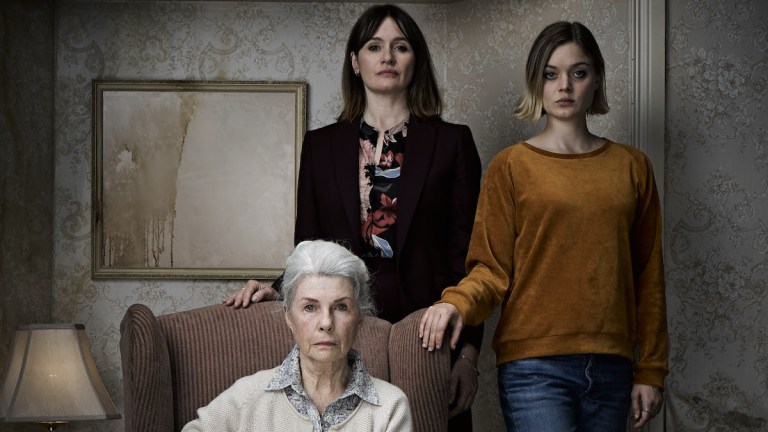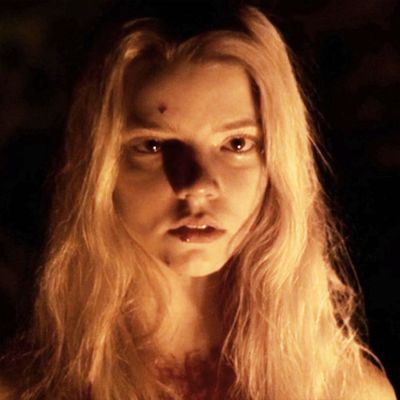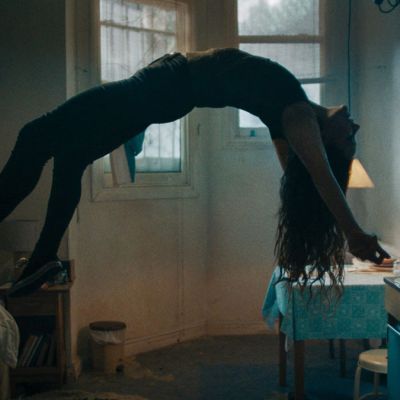How Relic Explores our Most Primal Fears
Director Natalie Erika James on how Relic delves into grief, mortality and fear of losing yourself.

All the major releases of 2020 have been postponed or released via streaming and cinemas are holding on by their fingertips, it hasn’t exactly been a stellar year for film. But as is so often the cast, one genre is holding on strong – horror. One of the very best horror movies of the year is Relic, a highly emotional, deeply creepy story of a woman with dementia and the daughter and granddaughter who come to care for her in her dilapidated old home. It’s a haunted house story of sorts where at times it’s the house itself that is doing the haunting.
Japanese-Australian director Natalie Erika James says she was a total scaredy cat as a child but her experience of watching a horror movie on the big screen with friends – which she describes as “The closest that you can get to death without dying” – gave her a thrill that she’s carried into her debut feature. It’s an incredibly personal piece with terrific performances from its triptych of women – Robyn Nevin as Edna, Emily Mortimer as her daughter Kay and Bella Heathcote as her granddaughter Sam.
Relic played FrightFest and The London Film Festival to great acclaim and in any other year it would be one of those buzzy genre movies everyone is piling into cinemas to see (check out our Relic review)
Fortunately, while Relic was released to VOD in the States, in the UK the film is getting a theatrical release so others can share James’ experience of being terrified collectively (albeit wearing masks and socially distanced).
James sat down with Den of Geek (via Zoom) to talk about the beauty of horror, creating a labyrinth and creating an animatronic gran.
You described your experience with horror as “The closest that you can get to death without dying.” That seems to be a very fitting description of where Relic lies…
Right. You can probably tell, it came from a really personal place. My grandmother had Alzheimer’s and she suffered for quite a number of years. And I was intrigued by the changes in her relationship with my mother and the dynamics there shifting, I suppose, where the child has to become the parent to their parents. I started writing the film on a trip that I took to Japan to go see her. And it was quite notable to me because it was the first time she couldn’t remember who I was.
I had a lot of feelings of guilt about that. And at the same time I would spend my summers at her house and it used to always scare me as a kid. Those two things coalesced in my mind.
People with Alzheimer’s, there can be moments of absurdity and levity that come from their condition, but also there can be very scary moments as well. Maybe unsettling is more the word. If they’re talking to people who aren’t there or who have passed. Or they’re convinced there’s someone in the closet or whatever it is. It felt like an appropriate genre to talk about fear in general, fear of mortality, fear of losing yourself, losing a parent, all those things.
The relationship between Sam and her grandmother is very affectionate and very tender and so some of the almost most unsettling moments are when she loses that.
Sometimes it feels like the grandchild-grandparent relationship can be very uncomplicated in a way that child and parent relationship can’t. So it’s, in a way, particularly heartbreaking when someone who’s only ever looked at you with love starts to turn.
You mention the house – production design is super important in Relic. Can you talk a little bit about that location?
We had two house locations. One was the exterior and the decaying grounds and one was the interior, mostly the downstairs. And then we actually built the upstairs bedrooms. We had to rebuild some of the hallways out to link everything together.
And of course it’s a labyrinth. It was almost a modular set in that we could take out areas to feel like there were different parts of it. And in that receding hallway, it’s more narrow. It was certainly a lot of creative problem-solving. And my production designer, Steven James Evans did an awesome job of putting it all together.
Did you have any particular inspirations for the look of the place?
I guess there’s a bit of Asian horror in that, the decaying nature of it. We wanted to stay away from anything that felt too overtly horror-signaling or Gothic with dark walls or anything from The Conjuring Universe. Instead we wanted it to feel like it was taking something familiar and something with a real deep sense of history and turning that on its head. Slowly making that comfort or familiarity unfamiliar over the course of the film in the same way that Edna is someone that you connect with and you feel for and care about and then she starts to really become a questionable presence. I suppose, in a way, it was more the Poltergeist approach of using lighter colors, blushes. Again, a real sense of history, the sense that things had once been really lived in and comfortable but that they were falling into decline and you could feel the neglect of that.
The imagery of Edna crafting the candles is fascinating and it slightly foreshadows what happens at the end, where did that come from?
Hilariously, it was originally an element that was changed because Hereditary came out when we were writing it. Originally Edna was making dollhouse furniture which was inspired by a short I did where the father had Alzheimer’s and it was a proof of concept for Relic. And his chairs were warping over time. So we were planning to just transpose that in Relic but, after Hereditary came out, we were a bit like, “Hm, it’s probably a bit too similar.” So we looked for another craft and we just settled on German candle carving. Certainly the idea of peeling and of layers was one of the reasons why we chose it.
You mention Hereditary and your film has obviously been spoken about in the same terms as that and, of course, The Babadook. How do you feel about that?
I take it as a compliment because I think they’re both wonderful, amazing, talented filmmakers. And I like both of those films so I’m totally happy with that. I wouldn’t necessarily call them direct references. Certainly, it was amazing to have seen the success of The Babadook in particular. Particularly because when I was pitching Relic around, people were really receptive to female-driven horror, it was something that people were looking for. So, timing wise, it couldn’t have been better.
Your story features three generations of women but would you say it’s a particularly female story or do you think it’s just a coincidence just because you happen to be a female?
I think it’s universal because we all have to deal with death in some way. I think the dynamics between the three women are specific to women, and particularly in the sense that caregiving often falls on women. So, I think it is specific to women in that way.
For me, it did come about naturally because it was my mother’s mother who had Alzheimer’s and those are just the relationships that are interesting to me personally. But I think there’s some specificity in it. I mean, I really liked the idea of three women because there’s a nice unity to seeing your future reflected in your mother and by extension her mother as well. So there’s something in that, that I don’t think would be as potent if it was, say, a mother-mother-son combination.
That final image of the three women holding each other is very specific and was very moving.
The idea of someone giving you life and how that loops around to the end, maybe. Obviously, men have a role in that as well, but something about them birthing is very physical.
Can you tell us a bit about shooting the labyrinth scenes towards the end?
The labyrinth was incredibly tricky. Partly because we were 40% over budget on what we wanted to build so we had to literally slash under half of it. We had to make the set a bit modular so that we could take away areas and make it feel like a different part of the set. And so it was a bit of a logistical nightmare with having to change sets in between set ups, and that kind of thing. But in a lot of ways the space so mirrors the disorientation and, I guess, almost the idea that Sam and Kate are being drawn into Edna’s experience quite physically as well. For me, the labyrinth is particularly key because it was one of the first images of the film that I had.
Relating it back to my grandmother, there was an upstairs area to the house where there were a couple of rooms that were just full of stuff and old furniture and memories and whatever storage space. And there was something really sinister and kind of heartbreaking about these rooms full of memories that just kept going deeper into the house and that you could lose yourself in that space.
And at the same time I’d seen, I think, a YouTube video or a documentary about a man who had Alzheimer’s and was describing feeling lost within his own house and that he’d often go to the kitchen and forget how to get back to the bedroom. So that always really stuck with me.
That’s really tough
It’s hard to shoot scenes like that, which are very high intensity emotionally but also where you have to cover a lot of ground because it’s being cut faster as well, so there’s a lot of coverage that you need to pull it off. There’s things that need to be reset, like wall breakaways as well, that are quite finicky.
It was all pushed to the end of the shoot and it was a very gnarly week. But so fun! I really could never anticipate how much I would fall in love with stunts in particular during this. I’d already had a massive, keen interest in prosthetics and visual effects. I don’t know if it was just the team but there’s something so incredibly exciting about it, especially paired with such wonderful actors and their performances.
Can we talk a little bit about the cast? So how did those guys come on board? And what were you looking for in those three characters?
It was definitely more of a creative discussion, I would say, of what pairings would work as a family because obviously they’re moving pieces. I had the opportunity to meet all three of them in person, which is wonderful, to be able to get a sense of who they were and what they read from the script as well. So I think, from the get-go, it was very clear to me that they all connected with it in their own way and in their own experience of death, I guess.
For Edna’s role I really needed someone who had a lot of charisma and a lot of range and who could, at one point be someone charming who you really were rooting for and who could turn on you the next moment. Robyn is just a force. And she has that intensity that was required but also is the sharpest, funniest person. So I think that combination was particularly striking.
For Kay’s role, interestingly, the feedback we kept getting was that she was very hard and unemotional as a character. And I always felt she was the most sympathetic, that she was caught between everyone. For us, she is the protagonist if you needed to single it down to one person. Someone like Emily softens all those hard edges because she’s just the most gracious and amiable charming person. So I felt like she was a good fit and it really was an ‘aha’ moment when we settled on her and thought of her. I’d long been a fan of her work. She has the most incredible instincts.
And with Bella’s character… I’d also been following Bella’s work for a while so I always knew I wanted to work with her. I guess, in the past she’s often been cast, because she’s so stunning physically, as quite feminine, demure characters. Then you meet her and she’s the most down to earth, cool chick. I really wanted a forthrightness in Sam that I saw in Bella and just a real honesty there and a toughness to her.
Where did the character of Jamie come from?
Jamie I can’t claim. He was actually more of Christian’s character, I have to say. Christian had been working on, I think it was a web series and one of his characters was a teenager who had down syndrome. I think we really wanted to sense that Edna had some support around her until she had driven that away. And I suppose that her loneliness had exacerbated the situation. So that was where Jamie came in.
Sound design is very important in the film as well. And it’s like these waves of echo. How did it work?
I really wanted to take quite a non-orchestral approach for this film and go with something that felt more diegetic and built from the worlds of the film. My composer, Brian Reitzell, was perfect because he does wonderful work of making his own instruments and strange sounds and capturing a feeling rather than focusing on melody or anything like that. He worked really closely with our sound designer, Rob Mackenzie and they each recorded sounds, whether that was made up instruments or them banging around in the house or whatever it was. Quite early they did that and so they had a shared library that they could both pull from. And that was great because it meant that there was a cohesive language to the design and the score.
I felt like I was underwater at points…
Yeah. Yeah. The echoes. Yeah. I mean, the house has such a presence as well. I guess there’s a sense of it really breathing in a way. And so finding those kinds of sounds were really key, like the breathing at the beginning of the film which is a slowed down heartbeat. Those were motifs that we decided on quite early.
Can you tell us a little bit about the final sequence – the peeling of Edna’s skin and how that worked?
Edna’s transformation had about nine stages.Stage one would have been the bruise and stage nine was actually an animatronic puppet.
They sculpted the silicon puppet and the animatronics were rigged so that you can control the smallest muscles in the face. I had two of the animatronics guys sitting next to me at the monitor with these car remote controls. It had a breathing mechanism so you had the movement of the chest too. It was really wonderful. And they sculpted the face off of Robyn’s face as well. So there was supposed to be some familiarity there as well.
In terms of the peeling, it was very difficult to reset, I have to say! Very fiddly, finicky. But Emily was just amazing. I mean, I think there’s such an emotional truth to that scene. It really is about almost helping someone die in a way, or a funeral rite if you want to read it that way. Not dissimilar to washing a loved one’s body after they’ve passed, something very intimate and visceral and very confronting, but ultimately an act of love.
It’s a very emotional film. How did you guys find that on set?
I feel like I maybe had a real, almost reverence for the puppet because it was such a beautiful piece of puppetry, to be fair. And I think it’s very easy to access the real life emotions when it just rings true and so we never really talked about it. We never really talked about it as a horror film. It was more like, “What does this mean? How does this relate to my own love for my parents and my own relationship with death?”
A lot of it feels like you’re trauma bonding with your actors. You have to be very honest with them because they’re so generous with you. It has to go both ways, I think.
Relic is having a theatrical release in the UK, is that important to you?
I mean, we did have a bit of a drive-in theater run and some local theaters in the U.S. But in Australia, in particular, it’s been a straight to VOD or rather a streaming platform called Stan. And to be fair, that was incredible to have as well because everyone was stuck at home at the time so it was like more people saw it than they ever would have. But I think there’s something about a cinema that maybe it’s a romantic notion, but as a filmmaker you really want people to get together to see it. Particularly for a horror film, you just want people to watch it in the darkness of the cinema and with the right sound levels and all the rest of it. I think there’s such a joy in that, in going through that horrific roller-coaster with people and surviving. I think that’s the beauty of horror.
Relic is released in UK cinemas and digital HD on 30th October.


